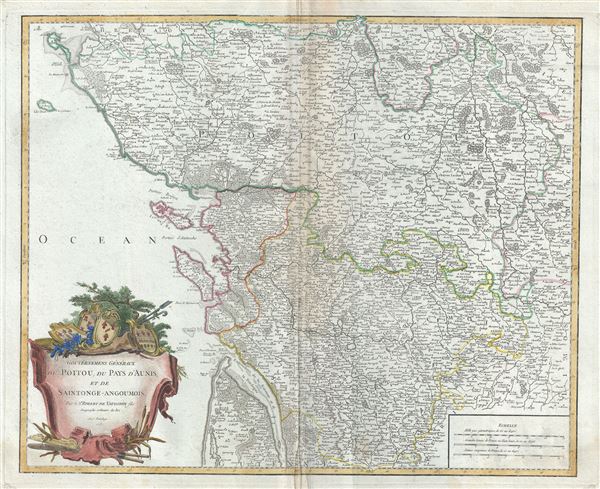This item has been sold, but you can get on the Waitlist to be notified if another example becomes available, or purchase a digital scan.
1753 Vaugondy Map of the Poitou-Charentes Region of France
PoitouPaysAunis-vaugondy-1757
Title
1753 (dated) 20 x 24 in (50.8 x 60.96 cm) 1 : 476000
Description
This region, which hugs the Loire Valley, is famed for is beautiful Chateaux and for producing some of the world's finest wines. Vendee is home to a number of small vineyards around the communes of Vix, Brem, Pissotte and Mareuil-sur-Lay. These wines are marketed under the 'Fiefs Vendeens' designation. Production quality has improved markedly over recent years, and, having already achieved the classification Vin Delimite de Qualite Superieure (VDQS), the wines are on their way towards A.O.C status (Appellation d'Origine Controlee). The rural area of Deux-Sevres produces fine wines such as Vin du Thouarsais, of Thouarsas. The cheese Chabichou is also made here. Chabichou is a traditional soft, unpasteurized, natural-rind goat cheese (or Chevre) with a firm and creamy texture.
The department of Charente is known for its fine Cognacs and Pineau wines, agriculture, and cheese. It produces a wide variety of goat cheeses, such as Chabichou, Mothais, Buche du Poitou, and Chabi. In fact, it produces a third of all the goat cheese in France. Charente Maritime is a coastal province bordering Charente, Dordogne, and Gironde (Bordeaux) is also known as the producer of the world's finest Cognacs. Vienne is renowned for its production of Chevre, or goat cheese, and is a vital industry in this department.
A beautifully engraved title cartouche adorns the bottom left quadrant of the map. Drawn by Robert de Vaugondy in 1753 and published in the 1757 issue of his Atlas Universal. The Atlas Universal was one of the first atlases based upon actual surveys. Therefore, this map is highly accurate (for the period) and has most contemporary town names correct, though historic names are, in many cases, incorrect or omitted.
Cartographer
Robert de Vaugondy (fl. c. 1716 - 1786) was French may publishing from run by brothers Gilles (1688 - 1766) and Didier (c. 1723 - 1786) Robert de Vaugondy. They were map publishers, engravers, and cartographers active in Paris during the mid-18th century. The father and son team were the inheritors to the important Nicolas Sanson (1600 - 1667) cartographic firm whose stock supplied much of their initial material. Graduating from Sanson's maps, Gilles, and more particularly Didier, began to produce their own substantial corpus. The Vaugondys were well-respected for the detail and accuracy of their maps, for which they capitalized on the resources of 18th-century Paris to compile the most accurate and fantasy-free maps possible. The Vaugondys compiled each map based on their own geographic knowledge, scholarly research, journals of contemporary explorers and missionaries, and direct astronomical observation. Moreover, unlike many cartographers of this period, they took pains to reference their sources. Nevertheless, even in 18th-century Paris, geographical knowledge was limited - especially regarding those unexplored portions of the world, including the poles, the Pacific Northwest of America, and the interiors of Africa, Australia, and South America. In these areas, the Vaugondys, like their rivals De L'Isle and Buache, must be considered speculative or positivist geographers. Speculative geography was a genre of mapmaking that evolved in Europe, particularly Paris, in the middle to late 18th century. Cartographers in this genre would fill in unknown lands with theories based on their knowledge of cartography, personal geographical theories, and often dubious primary source material gathered by explorers. This approach, which attempted to use the known to validate the unknown, naturally engendered rivalries. Vaugondy's feuds with other cartographers, most specifically Phillipe Buache, resulted in numerous conflicting papers presented before the Academie des Sciences, of which both were members. The era of speculative cartography effectively ended with the late 18th-century explorations of Captain Cook, Jean Francois de Galaup de La Perouse, and George Vancouver. After Didier died, his maps were acquired by Jean-Baptiste Fortin, who in 1787 sold them to Charles-François Delamarche (1740 - 1817). While Delamarche prospered from the Vaugondy maps, he defrauded Vaugondy's window Marie Louise Rosalie Dangy of her rightful inheritance and may even have killed her. More by this mapmaker...

